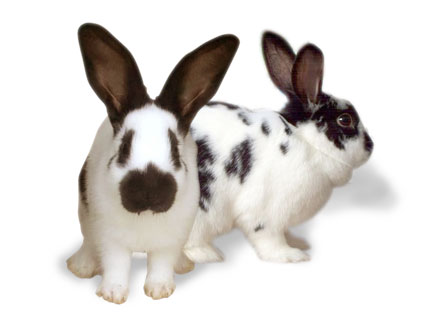Type the name of the breed you're looking for below
[wpdreams_ajaxsearchlite] Don't see the breed your're looking for? Click here and let us know!
Breed Characteristics
1 paw - breed exhibits the least amount of this characteristic
5 paws - breed exhibits most amount of this characteristic
Checkered Giant rabbit (Giant Papillon)
| Origin | It takes a special type of rabbit owner to raise Checkered Giants. He (or she) must have spacious housing facilities, because these bunnies are not only big, but active. He must have strong hands but a gentle touch in order to wrangle these rabbits. He must welcome the challenge of raising a breed where a goodly percent of the offspring produced won’t even be show-coloured. And it sure helps if at the end of the day, the sight of a well-marked Checkered Giant striking a pose stirs him to deeply admire “The Rabbit Beautiful.” At first glance, the “Checker” suggests a likeness to the English Spot breed. True, both are full-arch breeds that are not posed on the show table, but run the length of it. Agreed, they both display a spotted marking pattern caused by the broken gene. But look more closely and there are “giant” differences between the breeds. First, the Checkered Giant is much larger: having no maximum weight, but a minimum of 11 pounds for senior bucks and 12 pounds for senior does. The English Spot weighs only 5-8 pounds and is therefore a 4-class breed, while the Checker is six-class. English Spot breeders strive for an unbroken chain of spots from the cheek to the hip, while the Checkered Giant standard calls for two large patches of colour on either side of the hindquarters. Any spot on the shoulder is a disqualification. Both breeds have a spine marking, but the Checker should have a straight line of colour down the back, while the English Spot’s spine marking should be a jagged “herringbone” shape. In both breeds, type and markings are of nearly equal importance. However, the English Spot standard puts slightly more emphasis on the markings, and the Checker standard puts slightly more importance on body type. The origin of the Checkered Giant is clouded, though it probably originated in France. In the UK, the breed is slightly different in body type and markings, and called the Giant Papillion. Papillion means butterfly, which refers to the marking on a Checker’s nose. When you breed two correctly marked rabbits, some of the offspring will be solid colored, some will be mostly white rabbits called Charlies, and some will be marked. Even a percentage of the marked off spring will not have spots in quite the right places for show. |
Physical Attributes
| Weight | 11 lbs. (5 kg) MINIMUM |
| Ear Type | Erect |
| Fur Type | Flyback |
| Colours | Black, White and Blue |
| Appearance | White with spots of black or blue on the nose, check, back, and hindquarters. It has a racy type body with an arch to the back. The head is relatively large; ears long and erect. |
| Other Considerations | Life Expectancy: 5-6 years Temperament: Calm and gentle Some rabbit owners claim this breed takes extra care because the racier body is more prone to injury and the large size makes handling difficult. Not for a first-time rabbit owners. No maximum size! |
| Best Kept In | Pen, Yard or House |



